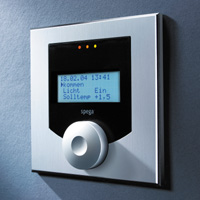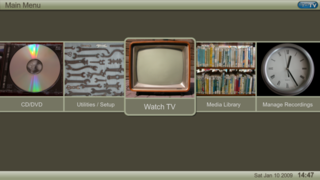Related Research Articles
A web portal is a specially designed website that brings information from diverse sources, like emails, online forums and search engines, together in a uniform way. Usually, each information source gets its dedicated area on the page for displaying information ; often, the user can configure which ones to display. Variants of portals include mashups and intranet dashboards for executives and managers. The extent to which content is displayed in a "uniform way" may depend on the intended user and the intended purpose, as well as the diversity of the content. Very often design emphasis is on a certain "metaphor" for configuring and customizing the presentation of the content and the chosen implementation framework or code libraries. In addition, the role of the user in an organization may determine which content can be added to the portal or deleted from the portal configuration.
In computing, a plug and play (PnP) device or computer bus is one with a specification that facilitates the recognition of a hardware component in a system without the need for physical device configuration or user intervention in resolving resource conflicts. The term "plug and play" has since been expanded to a wide variety of applications to which the same lack of user setup applies.

Home automation or domotics is building automation for a home. A home automation system will monitor and/or control home attributes such as lighting, climate, entertainment systems, and appliances. It may also include home security such as access control and alarm systems.
HVAC equipment needs a control system to regulate the operation of a heating and/or air conditioning system. Usually a sensing device is used to compare the actual state with a target state. Then the control system draws a conclusion what action has to be taken.
LonWorks or Local Operating Network is an open standard for networking platforms specifically created to address the needs of control applications. The platform is built on a protocol created by Echelon Corporation for networking devices over media such as twisted pair, power lines, fiber optics, and wireless. It is used for the automation of various functions within buildings such as lighting and HVAC; see building automation.
BACnet is a communication protocol for building automation and control (BAC) networks that use the ASHRAE, ANSI, and ISO 16484-5 standards protocol.

MythTV is a free and open-source home entertainment application with a simplified "10-foot user interface" design for the living room TV. It turns a computer with the necessary hardware into a network streaming digital video recorder, a digital multimedia home entertainment system, or home theater personal computer. It can be considered a free and open-source alternative to TiVo or Windows Media Center. It runs on various operating systems, primarily Linux, macOS, and FreeBSD.

A lighting control console is an electronic device used in theatrical lighting design to control multiple stage lights at once. They are used throughout the entertainment industry and are normally placed at the front of house (FOH) position or in a control booth.
A mashup, in web development, is a web page or web application that uses content from more than one source to create a single new service displayed in a single graphical interface. For example, a user could combine the addresses and photographs of their library branches with a Google map to create a map mashup. The term implies easy, fast integration, frequently using open application programming interfaces and data sources to produce enriched results that were not necessarily the original reason for producing the raw source data. The term mashup originally comes from creating something by combining elements from two or more sources.
Building automation (BAS), also known as building management system (BMS) or building energy management system (BEMS), is the automatic centralized control of a building's HVAC, electrical, lighting, shading, access control, security systems, and other interrelated systems. Some objectives of building automation are improved occupant comfort, efficient operation of building systems, reduction in energy consumption, reduced operating and maintaining costs and increased security.

A lighting control system is intelligent network-based lighting control that incorporates communication between various system inputs and outputs related to lighting control with the use of one or more central computing devices. Lighting control systems are widely used on both indoor and outdoor lighting of commercial, industrial, and residential spaces. Lighting control systems are sometimes referred to under the term smart lighting. Lighting control systems serve to provide the right amount of light where and when it is needed.

A home network or home area network (HAN) is a type of computer network that facilitates communication among devices within the close vicinity of a home. Devices capable of participating in this network, for example, smart devices such as network printers and handheld mobile computers, often gain enhanced emergent capabilities through their ability to interact. These additional capabilities can be used to increase the quality of life inside the home in a variety of ways, such as automation of repetitive tasks, increased personal productivity, enhanced home security, and easier access to entertainment.
Direct digital control is the automated control of a condition or process by a digital device (computer). Direct digital control takes a centralized network-oriented approach. All instrumentation is gathered by various analog and digital converters which use the network to transport these signals to the central controller. The centralized computer then follows all of its production rules and causes actions to be sent via the same network to valves, actuators, and other heating, ventilating, and air conditioning components that can be adjusted.
Philips Dynalite is a lighting control and automation system developed in Sydney, Australia by John Gunton in 1987.
oBIX is a standard for RESTful Web Services-based interfaces to building control systems. oBIX is about reading and writing data over a network of devices using XML and URIs, within a framework specifically designed for building automation.
The Virtual Cybernetic Building Testbed (VCBT) is a whole building emulator located at the National Institute of Standards and Technology in Gaithersburg, Maryland. It is designed with enough flexibility to be capable of reproducibly simulating normal operation and a variety of faulty and hazardous conditions that might occur in a cybernetic building. It serves as a testbed for investigating the interactions between integrated building systems and a wide range of issues important to the development of cybernetic building technology.
Physical security information management (PSIM) is a category of software that provides a platform and applications created by middleware developers, designed to integrate multiple unconnected security applications and devices and control them through one comprehensive user interface. It collects and correlates events from existing disparate security devices and information systems to empower personnel to identify and proactively resolve situations. PSIM integration enables numerous organizational benefits, including increased control, improved situation awareness and management reporting. Ultimately, these solutions allow organizations to reduce costs through improved efficiency and to improve security through increased intelligence.

KMC Controls has designed and manufactured HVAC control system products and building automation systems since 1969. KMC was one of the early privately held controls manufacturer with a full line of digital, electronic, and pneumatic products in the United States. The latest products include BACnet digital controllers and thermostats.
WebUSB is a JavaScript application programming interface (API) specification for securely providing access to USB devices from web applications.
A smart home hub, sometimes also referred to as a "smart hub", "gateway'", "bridge", "controller" or "coordinator", is a control center/centre for a smart home, and enables the components of a smart home to communicate and respond to each other via communication through a central point. The smart home hub can consist of dedicated computer appliance, software appliance, or software running on computer hardware, and makes it possible to gather configuration, automation and monitoring of a smart house by communicating and controlling different smart devices that consist of for example home appliances, sensors and relays or robots, many of which are commonly categorized under Internet of things.
References
- ↑ Kaufman, Ira; Horton, Chris (2015). Digital Marketing: Integrating Strategy and Tactics with Values, A Guidebook for Executives, Managers, and Students. New York: Routledge. p. 33. ISBN 9780415716741.
- ↑ Chen, Yu-Che (2017-07-20). Managing Digital Governance: Issues, Challenges, and Solutions. Routledge. ISBN 9781351801348.
- ↑ Wierzbicki, Andrzej; Nakamori, Yoshiteru (2005). Creative Space: Models of Creative Processes for the Knowledge Civilization Age . Berlin: Springer Science+Business Media. pp. 186. ISBN 3540284583.
- ↑ Krause, Frank-Lothar (2007). The Future of Product Development: Proceedings of the 17th CIRP Design Conference. Berlin: Springer Science+Business Media. p. 116. ISBN 9783540698197.
- ↑ Smith, Ryan (2010). Prefab Architecture: A Guide to Modular Design and Construction . Hoboken, NJ: John Wiley & Sons, Inc. pp. 69. ISBN 9780470275610.